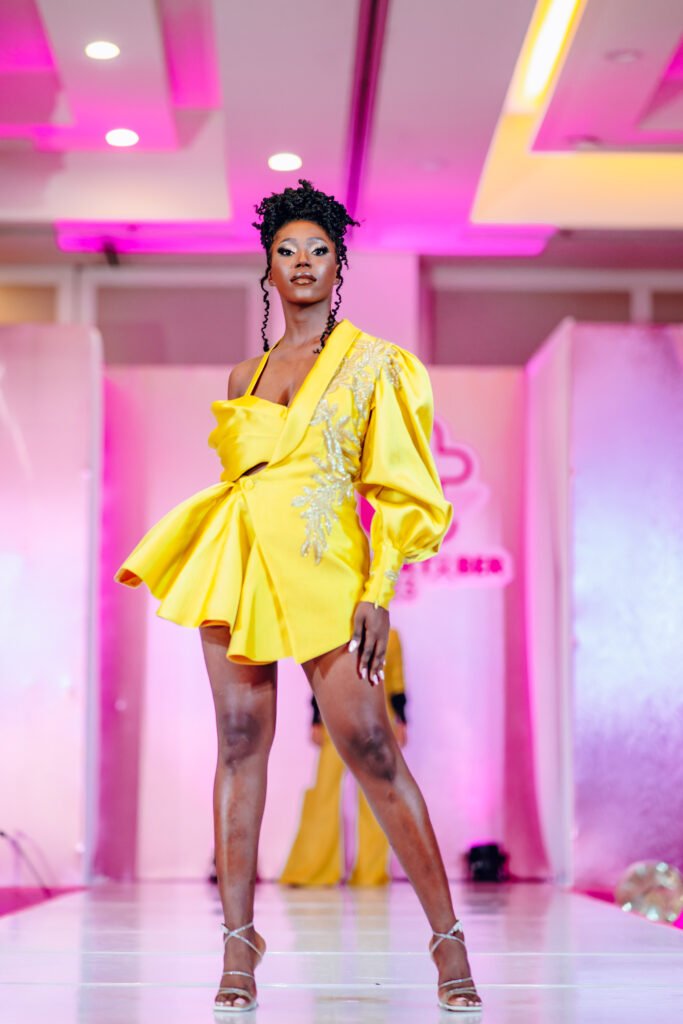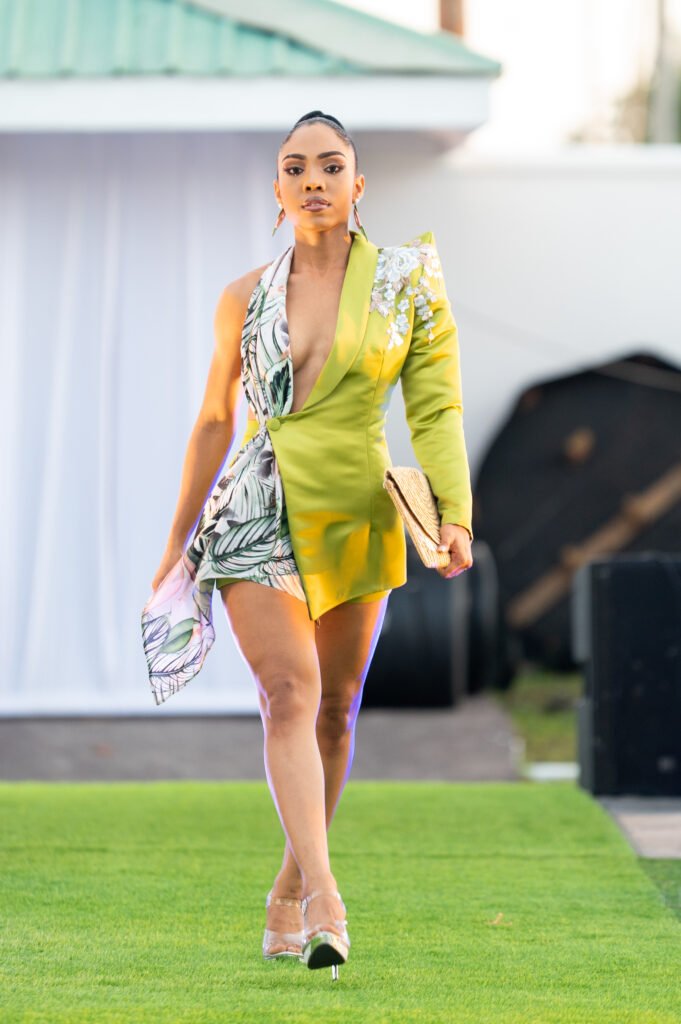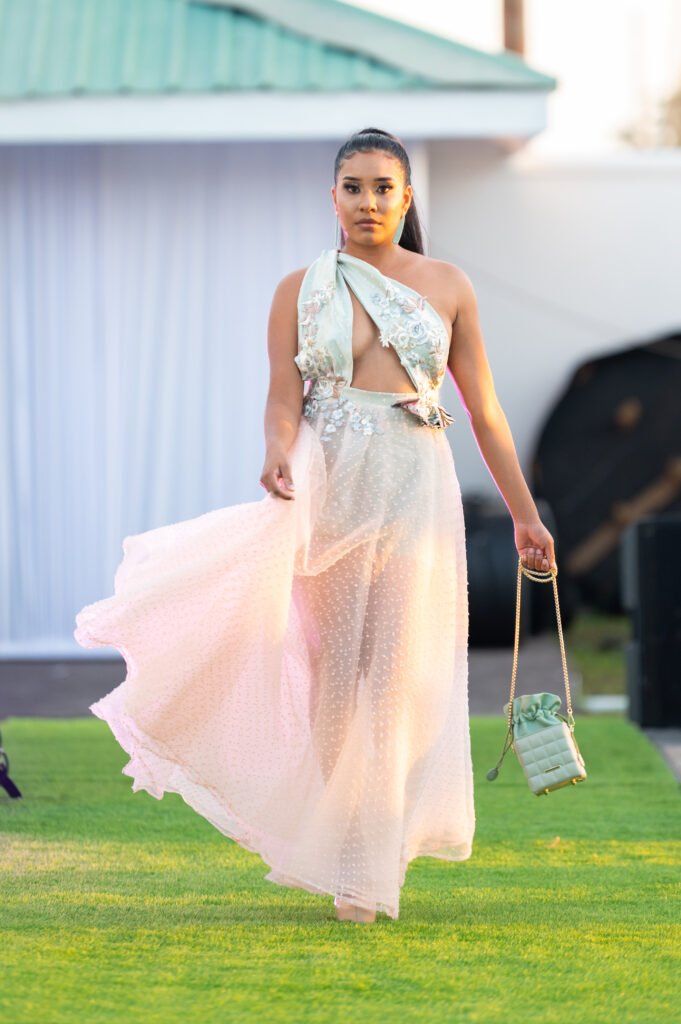In the dynamic yet diverse world of Caribbean fashion, there are a few names that stand out, and Keisha Edwards is undoubtedly one of them. As the founder of Shasha Designs, Keisha has made a significant impact on the Caribbean fashion scene at an incredibly young age, bringing a unique blend of creativity, passion, and innovation to the industry.
In our latest feature, we had the privilege of interviewing Keisha, delving into her journey, her inspirations, and her vision for the future of Caribbean fashion. A recipient of the prestigious Chevening Scholarship pursuing her Master’s Degree in Fashion Business Management from the University of Westminster in the United Kingdom, Edwards shares her insights on the challenges and opportunities in the Caribbean fashion space, and how she sees her brand evolving in the coming year.
Tell us about Shasha Designs: As the founder, what inspired you to create this brand, and what unique elements do Shasha Designs bring to the Caribbean fashion scene?
Shasha Designs, the name given to me by my sister, was born out of necessity. I graduated from the University of Guyana with a Diploma in Social Work and a Degree in Sociology, but I could not find a job; I was told I was overqualified for the jobs that I applied to, so I turned to creating and sewing, which came naturally to me. I had to turn my skills into a viable career that would sustain me; I had no formal training then and knew nothing about business. I knew I had to provide for myself, and it helped that I also had my supportive sister, who kept telling me I should start a clothing brand. Design for me was about sharing my ideas and telling stories through stylish clothing for women for their special occasions; I wanted them to stand out at every event.
Shasha Designs is a Caribbean Luxury brand that creates statement pieces for women, and we specialise in traditional and unconventional wedding gowns. We bring to the Caribbean fashion scene that we create statement pieces by reimagining classic looks and infusing them with a fresh new perspective that is classic or traditional yet reflective of the era. Every collection is different, sometimes telling something new about my culture or story; however, what is consistent is the technical elements that I incorporate into my designs. I think that retelling our culture is extremely important to the existence of the Caribbean.

How would you describe the current state of the Caribbean fashion industry? What challenges and opportunities do designers face in this region?
The Caribbean Fashion Industry is a melting pot of diverse creativity. Even though we all don’t speak the same language, we share similar stories that can be understood through the clothing that we create. At the same time, there is a notable emergence of distinct brand narratives, creativity, and craftsmanship from designers across the Anglo, Spanish, French and Dutch-speaking Caribbean. As well as the recognition of designers on a global stage, like Fenoel, Stella Jean, Maximillian Davis, Theodore Elyett, and Phylicia Ellis, to name a few; however, these are still just a handful of designers, and the industry still grapples with challenges that hinder its growth and global competitiveness.
One of the primary challenges facing designers in the Caribbean is access to sustainable infrastructure and resources essential for fostering a supportive fashion sector. Despite the recognition of talented designers, and we have many, the industry lacks sufficient scale to leverage their potential impact fully. Additionally, there are significant gaps in infrastructure, market segmentation, and access to highly qualified personnel, which limit the industry’s ability to flourish. Furthermore, the uneven nature of the local fashion sector and the absence of clear market segments and design markets pose obstacles to cohesive industry development.
However, amidst these challenges lie opportunities for transformation and advancement. By fostering an environment rooted in principles of Global connectivity, clear transparency, creativity, collaboration, DEI, sustainability, innovation, research, and global connectivity, the Caribbean fashion industry can unlock its full potential. Strategic efforts to cultivate governmental support and the support of CARICOM can be instrumental in paving the way for a sustainable, globally competitive fashion industry that drives economic growth, fosters employment, and positively impacts the socio-economic development in the region.
(I’ll also add that some Fashion Industries in the Caribbean are doing better than others like the Dominican Republic, Jamaica, Bahamas, BVI, Trinidad and Tobago, to name a few)
How does Shasha Designs contribute to promoting diversity and representation within Caribbean fashion? Are there specific cultural influences that inspire your designs?
We promote diversity and representation within Caribbean Fashion by celebrating our rich cultural heritage and retelling Guyanese stories through our different collections modelled by different ethnic identities of varying skin tones and sizes to be a part of the story. Guyana, like the Caribbean, is a mixture of cultural identities. Colourism is a major issue throughout the region, and having experienced it myself in Guyana, for me it is essential to bring that diversity and visibility to the runway. Our designs sometimes highlight the diverse identities and experiences within the Caribbean community. Additionally, the brands focus on creating statement pieces that make our clients stand out in any environment, reinforcing the narrative that Caribbean fashion is not monolithic but rather a reflection of a multifaceted culture.



Our Recent Collection, The Lost City, was showcased on the Moonlight Stories runway show (Guyana’s First Gala and Runway Show, that I am the curator of), which is a show that has a yearly theme around Guyanese culture and folklore, gives a platform to myself and other designers to showcase their talent as well as retelling our Guyanese stories through Fashion Music and art; this also allows for the conversation of history and culture to reemerge into this generation, we don’t talk about our history and culture often, and Moonlight stories and these collections are a way of keeping the youth engaged while keeping our history and culture alive and relevant.
Sustainability is a growing concern globally. How does Shasha Designs incorporate sustainable practices into its production processes? What steps are you taking to minimise the environmental impact?
Sustainability is a significant issue, especially when the global fashion industry is a major environmental polluter. I must play my part in ensuring our actions are good for the environment. Our sustainable models are practised in slow fashion and fair trade. With SF, we focus on creating pieces on a small scale, focusing on construction, extravagant fabrics, and attention to detail to ensure our customers receive a garment made with love and pass it down instead of throwing it away. Waste fabrics are sometimes used on other clothing, and pieces are upcycled and given a new life. The reality is sustainability because it is more complex when scale becomes a part of the conversation. We aren’t 100% or 60% sustainable, but we are learning and doing our best to improve. I look forward to seeing how this model develops as the brand grows.
Sustainability isn’t only about the environment but also about ethics. I am focused on building and making connections with people, so it is crucial to foster an ethical working environment with the people we employ on a short-term and long-term basis, fair labour conditions, they work in a safe environment, they are compensated for the work that they do, etc. Fair Trade is essential in this business; I want people to be happy and excited to be a part of the brand’s story.
Congratulations on being the first Guyanese creative professional to receive the Chevening Scholarship! Could you share your experience studying Fashion Business Management at the University of Westminster? How has this scholarship impacted your career and vision for Shasha Designs?
Thank you, it has been such a fantastic eye-opening experience thus far; as creatives, we tend to focus a lot on the creative aspect of our business, sometimes forgetting that the creative element is just 10% and the business of fashion, is where the majority of the work is. Relying on this aspect allows your business to scale and thrive.
Studying Fashion Business Management at the University of Westminster through the Chevening Scholarship is an incredible experience. It provides me with a comprehensive understanding of the business side of the fashion industry, including retail, strategic fashion management, visual merchandising, branding, finance, supply chain management, etc. The opportunity to learn from industry experts and collaborate with fellow students and Chevening Scholars from diverse backgrounds has enriched my learning experience and expanded my professional network. I’ve had many group projects working with people for whom English is not their first language. It was challenging at first, but I’m very happy to have had that experience because it revealed to me the level of patience and understanding that I had for my team and in general. For me, it was important for everyone in my group to feel seen and heard.
The Chevening Scholarship has significantly impacted my career and vision for Shasha Designs. This scholarship to the University of Westminster has equipped me with the knowledge, skills, and conviction to take my fashion business to the next level. I’ve gained valuable insights into the global fashion industry, trends, consumer behaviour, and best practices in the industry, which has informed my strategic decision-making and business planning.
I am incredibly grateful to the Foreign Commonwealth and Development Office for the opportunity to receive the prestigious Chevening Scholarship. It was a celebration for the creatives in my country and the region. I want creatives to know that Chevening is for us also, and it is an opportunity for creatives across the region to develop their knowledge in their industry further and to experience living in a global city so that they can return with innovative ideas and concepts to build their industry and to share the knowledge given.
Overall, the scholarship has been a transformative experience that has empowered me to pursue my passion for fashion and contribute to the development of the Caribbean fashion industry on a global scale. I have so much time left, and I am making the most of my experiences.
How has your time in London influenced your perspective on fashion? Have you had opportunities to collaborate with other international designers or attend industry events?
I am still processing the experience; living and studying in this cosmopolitan city that is also my favourite fashion capital in the world has exposed me to various innovations in fashion design, trends, subcultures and design aesthetics. This exposure fosters a more open-minded approach to fashion, encouraging experimentation and exploring London’s style. The Museums, art galleries, luxury stores, designer boutiques, numerous fashion shows, London Fashion Week, high street brands and street style culture provide endless inspiration and opportunities for creative expression. Seeing how AI is used to personalize your shopping experience and save you time, the fabrics that are being created. What is being done with technology in fashion and what it could mean for the fashion industry in the years to come is quite extraordinary. It is broadening my perspective on the areas of fashion outside of design. I am excited to embrace every opportunity and innovation and what it could mean for the future of fashion in Guyana and the Caribbean Region.
Describe the signature style of Shasha Designs. What elements make your creations stand out, and how do you infuse Caribbean culture into your designs?




We blend Guyanese and Caribbean culture with a luxe finish. Shasha Designs uses classic silhouettes, symmetrical lines, and innovative cuts to create designs that tell my lived Guyanese/Caribbean experiences. I am known for reinventing sartorial looks. When it comes to design, I ask myself how can make a garment different from a 360 point of view.
The beauty of Caribbean culture is that it’s so diverse, with so many religions, different ethnicities, Africans, Chinese, Indians, Portuguese, Spanish, etc, colours, dance and music; all of these elements can and have influenced my work.
As a designer and entrepreneur, what advice would you give to aspiring fashion professionals in the Caribbean? How can they navigate the industry’s business side while staying true to their creative vision?
My advice to aspiring fashion professionals in the Caribbean would be to take every workshop, seminar, and class seriously and use it to build meaningful connections with people with whom you can collaborate, in the future. Be a sponge and learn from everyone, not only the people in your industry but also those outside of it; if there is a writing course, take it; this skill will be useful in learning how to write to apply for grants or scholarships to further your studies to increase your knowledge in your industry.
Crafting a solid business plan is fundamental to your success. This plan should detail your objectives, target audience, marketing strategies, financial forecasts, and operational framework. A clear roadmap will keep you focused and organised as you navigate the complexities of starting and growing a fashion business. Regularly revisiting and updating your business plan will help realign your efforts whenever necessary.
Blending your creativity with strategic business insight is the key to steering a successful course and establishing a growing fashion business that leaves an indelible mark. While understanding the business aspects is imperative, safeguarding your creative essence is equally vital. Making time for yourself to recharge, reimagine, and reinspire oneself is essential. It allows you to uphold your distinct style and artistic integrity, for it is your signature that will elevate you above the competition and maintain a competitive advantage in the market.
What exciting projects or collections can we expect from Shasha Designs in the near future? Are there any collaborations or partnerships on the horizon?
Yes, there are a few collaborations in the works from the UK that I am excited about, but it is in the early stages, so I can’t say much.



Two years ago, I applied for a Cultural creative grant in my country and was a successful recipient of a million-dollar grant (gyd), which allowed me to curate a Fashion Gala and Runway Show titled Moonlight Stories that ran for two years incorporating fashion, art and music under the theme Guyanese folklore. This event lent visibility to the creative work of talented artisans and musicians in my country and created employment opportunities for many in Guyana. Designers and artists created pieces that reflected the folklore shared within Guyana and the region. This event was made possible also with the aid of private sector partners like Bromeliadrnc, Glo Aesthetics, Disinco Trading, Supreme Laundromat, Shaws Media, to name a few, I say all of this to say, these grand events are not possible without the support of the private and public sector, so I look forward to hosting it for another year and this time inviting designers from across the region to tell their stories and culture through fashion, music and art, so there is a lot that I and my team are currently working on.
I strongly believe in giving back and I am working on a proposal and syllabus for Guyana to collaborate with the Ministry of Culture and the Ministry of Education for an accelerator design program. To support young persons interested in fashion in developing their skills and getting them export-ready while educating them about the business side of fashion. Especially for persons in school to know that this too can be a viable career path so that when they start their business, they are equipped with the tools to run it efficiently. I hope to collaborate with the network of specialised creatives in the field across the region that I have connected with (over my years in the CFI) to be a part of this project of sharing knowledge and skills. I hope to pitch this project to both the private and public sectors for support. I am incredibly hopeful and am proposing this project because it is needed and this type of support is required within Guyana’s fashion Industry and, by extension, the Caribbean.
Finally, how do you envision the future of Caribbean fashion? What role do you see Shasha Designs playing in shaping this vibrant and diverse industry?
In envisioning the industry’s future, I see a continued rise in international recognition and demand for Caribbean fashion, driven by the region’s uniquely diverse aesthetic, craftsmanship, and storytelling. I also see increased collaboration and cross-pollination between Caribbean designers and partnerships with international brands and retailers to expand market reach and distribution channels. An economically thriving Caribbean fashion industry is one where local designers and brands can access robust infrastructure, resources, and support systems that enable them to create high-quality, innovative products and compete globally. We have to start by working together. The industry fosters creativity, entrepreneurship, and sustainability while celebrating the region’s diverse cultural heritage. This can only happen with the support of our Governments, Caricom, fashion designers, fashion professionals and specialised persons in the industry collaborating and working together. I am still defining in my mind what my role is in all of this but what I do know is that I will continue to come up with innovative concepts, collaborate, share knowledge, lend support and encourage anyone interested in being a part of this industry.
You can connect with Keisha and Shasha Designs via their website and Instagram page.














